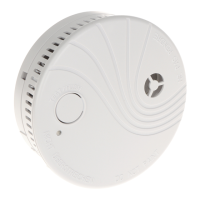Nuisance alarms occur when smoke alarms are installed where they will not work properly. To avoid nuisance alarms, do not install smoke alarms in the
following situaons.
• In or near areas where combuson parcles are present, such as kitchens with few windows or poor venlaon, garages where there may be vehicle
exhaust, near furnaces, combuson heaters, and space heaters. Combuson parcles are the by-products of something that is burning, which the smoke
alarm may detect.
• Within 6 m of kitchens where combuson parcles are normally present. If a 6 m distance is not possible, e.g. in a mobile home, try to install the smoke
alarm as far away from the combuson parcles as possible. Ensure the area is well venlated.
• In dead-air areas, where venlaon systems cause air-flow that would not pass through the smoke alarm sensing chamber. Avoid also air-flow from areas
where normal combuson parcles are expected, such as kitchens.
• In damp or very humid areas, or within 3 m of bathrooms with showers. Moisture in humid air can enter the sensing chamber, then condense into droplets
upon cooling, which can cause nuisance alarms.
• In very cold or very hot areas, including unheated buildings or outdoor rooms. If the temperature rises above or falls below the operang range of smoke
alarm, it may not funcon properly. The temperature range for your smoke alarm is -10 °C ~ 60 °C.
• In very dusty or dirty areas. Dirt and dust can build up on the smoke alarm’s sensing chamber, to make it overly sensive. Addionally, dust or dirt can block
openings to the sensing chamber and limit the smoke alarm from sensing smoke.
• Near fresh air vents or high dra areas like air condioners, heaters or fans, fresh air vents and dras, which can drive smoke away from smoke alarms.
• In dead air spaces, which are oen at the top of a peaked roof or in apex of ceilings and walls. Dead air may prevent smoke from reaching a smoke alarm. See
Fig. 2, Fig. 3, Fig. 4 and Fig. 5 for recommended mounng locaon.
• In insect-infested areas. If insects enter a smoke alarm’s sensing chamber, they may cause a nuisance alarm. Where insects are a problem, get rid of them
before installing the smoke alarm.
• Near fluorescent lights. Electrical “noise” from fluorescent lights may cause nuisance alarms. Do not install smoke alarms within 1.5 m of such lights.
Where Not to Install the Smoke Detector
Figure 5 Mounng in rooms with sloping ceiling and horizontal ceiling
1.Check the signal strength.
1.Draw a 150 mm line at the required place.
2.Rotate the mounng bracket counter -clockwise and remove it from the detector.
3. Align the two longest hole slots with the drawed line. Draw a mark In each of keyhole slots.
4.Drill two 5 mm (3/16-inch) holes at the marks and insert the plasc mounng plugs (supplied).
5.Aach the bracket to the ceiling with the screws supplied.
6.Align the slot of the bracket with the detector, push the detector onto the mounng bracket,
and rotate it clockwise to finish the mounng.
Mounng with Screws
Mounng
3
Tap the Signal Strength Test in the Hik-ProConnect to enter the mode and tap the test buon:
Solid green for 3 s - Strong Signal
Flashing green for 3 s - Medium Signal
Solid red for 3 s - Weak Signal
Flashing red for 3 s - Failure
Signal Strength Test
T
E
S
T
/
H
U
S
H
T
E
S
T
/
H
U
S
H

